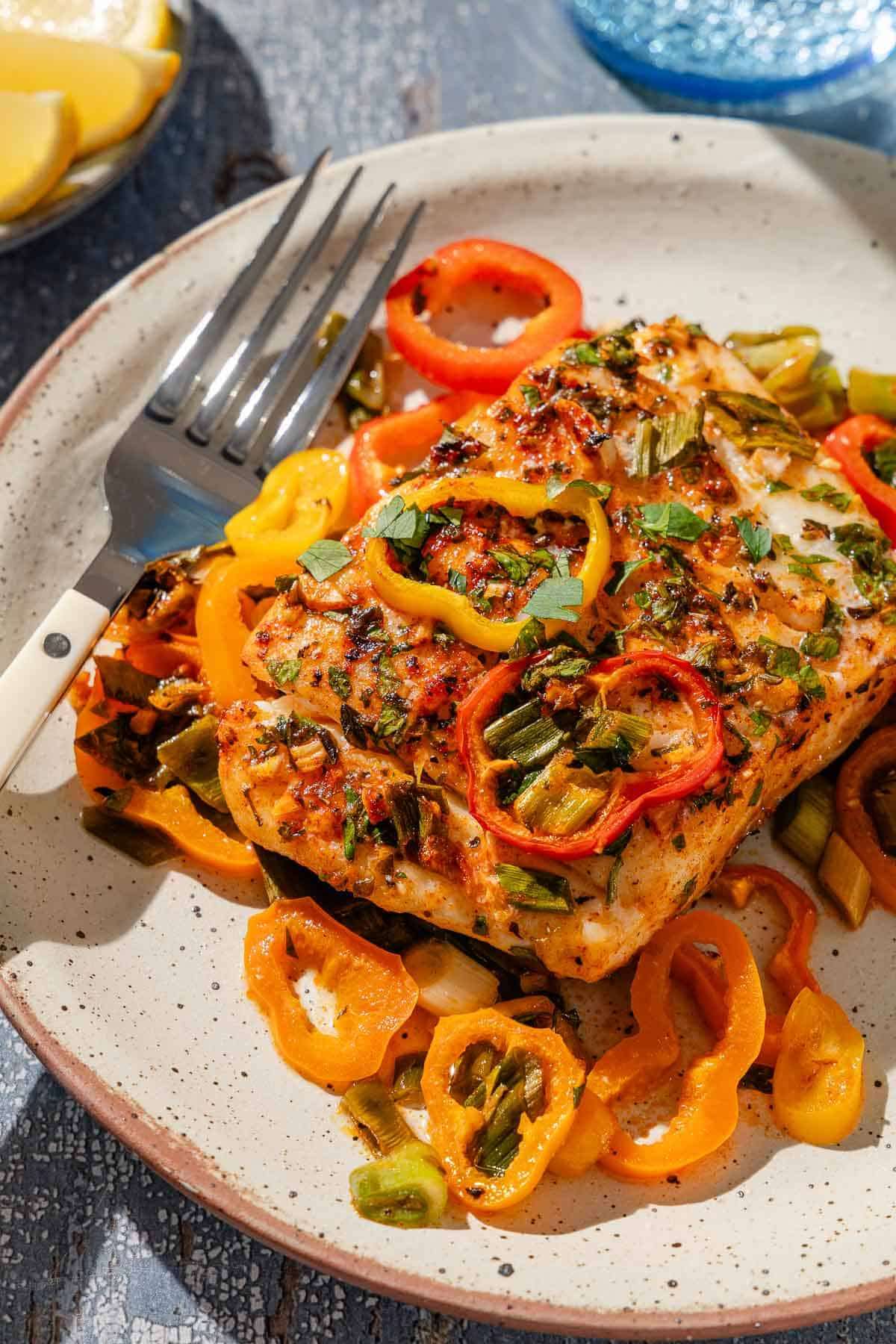
5.0 from 9 votes
Baked Haddock with Baby Bell Peppers
Haddock is a wonderful, quick, and easy weeknight Mediterranean Diet recipe. If haddock is hard to find, you can substitute cod or halibut.
Prep Time
15 mins
Cook Time
15 mins
Servings: 4 people
Calories: 1879 kcal
Course:
Main Course
Cuisine:
Mediterranean
Ingredients
- 4 haddock fillets, (4 to 6 ounces each)
- kosher salt
- black pepper
- 8 Baby bell peppers, any color, sliced into thin rounds
- 4 green onions, both white and green parts, trimmed and chopped
- 2 large garlic cloves, minced
- 1 1/2 teaspoons greek oregano
- 1 teaspoon paprika
- 1 lemon, zest and juice
- extra virgin olive oil
- 1/4 cup Finely chopped fresh parsley, plus more for serving
- lemon wedges for serving
Instructions
- Get ready. Position a rack in the middle of the oven and heat the oven to 400°F.
- Prep the haddock. Pat the fish dry on both sides and season well with kosher salt and black pepper then place it in a large mixing bowl.
- Season the haddock and vegetables. To the bowl with the fish, add the baby bell peppers, green onions, garlic and parsley. Season with the oregano, paprika, and a little more salt and pepper. Add the lemon juice, lemon zest and about 1/4 cup of extra virgin olive oil. Toss well to combine, making sure the fish and vegetables are fully coated with the seasoning.
- Bake the haddock and vegetables. Transfer the fish and vegetables to a 9 x 13 baking dish. Bake in the heated oven until the fish is opaque and flakes easily at the touch of a fork, about 15 minutes.
- Finish and serve. Garnish with more chopped parsley, and serve immediately with fresh lemon wedges on the side.
Cup of Yum
Notes
- to browse quality Mediterranean ingredients including the
- olive oil,
- and paprika
- used in this recipe.
- How to Store Baked Haddock: Baked haddock is best eaten immediately, but leftovers will keep in the fridge in an airtight container for up to 2 days. Use leftover haddock chilled in a salad, like this Greek Salmon Salad, or as a topping for toasts, as in this recipe for Sardine Toasts. If you must, you can reheat the fish and vegetables covered, with a little water in the pan, in a 350°F oven just until warmed through.
- Baked haddock is best eaten immediately, but leftovers will keep in the fridge in an airtight container for up to 2 days.
- Use leftover haddock chilled in a salad, like this
- Greek Salmon Salad
- , or as a topping for toasts, as in this recipe for
- Sardine Toasts
- . If you must, you can reheat the fish and vegetables covered, with a little water in the pan, in a 350°F oven just until warmed through.
- Shop this recipe: Visit our shop to browse quality Mediterranean ingredients including the olive oil, Greek oregano and paprika used in this recipe.
- How to Store Baked Haddock: Baked haddock is best eaten immediately, but leftovers will keep in the fridge in an airtight container for up to 2 days. Use leftover haddock chilled in a salad, like this Greek Salmon Salad, or as a topping for toasts, as in this recipe for Sardine Toasts. If you must, you can reheat the fish and vegetables covered, with a little water in the pan, in a 350°F oven just until warmed through.
Nutrition Information
Serving
4g
Calories
187.9kcal
(9%)
Carbohydrates
8.3g
(3%)
Protein
33g
(66%)
Fat
2.7g
(4%)
Saturated Fat
0.6g
(3%)
Polyunsaturated Fat
0.7g
Monounsaturated Fat
0.8g
Cholesterol
83.3mg
(28%)
Sodium
123.2mg
(5%)
Potassium
975.7mg
(28%)
Fiber
2.9g
(12%)
Sugar
3.4g
(7%)
Vitamin A
2567.9IU
(51%)
Vitamin C
93.7mg
(104%)
Calcium
52.5mg
(5%)
Iron
1.5mg
(8%)
Nutrition Facts
Serving: 4people
Amount Per Serving
Calories 1879
% Daily Value*
| Serving | 4g | |
| Calories | 187.9kcal | 9% |
| Carbohydrates | 8.3g | 3% |
| Protein | 33g | 66% |
| Fat | 2.7g | 4% |
| Saturated Fat | 0.6g | 3% |
| Polyunsaturated Fat | 0.7g | 4% |
| Monounsaturated Fat | 0.8g | 4% |
| Cholesterol | 83.3mg | 28% |
| Sodium | 123.2mg | 5% |
| Potassium | 975.7mg | 21% |
| Fiber | 2.9g | 12% |
| Sugar | 3.4g | 7% |
| Vitamin A | 2567.9IU | 51% |
| Vitamin C | 93.7mg | 104% |
| Calcium | 52.5mg | 5% |
| Iron | 1.5mg | 8% |
* Percent Daily Values are based on a 2,000 calorie diet.